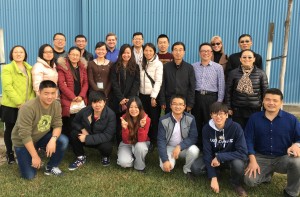Food Safety Conference Achieves a Virtuous Cycle
Chris Brunner, January 14, 2016

Dean Michael Lairmore welcomes conference participants to the School of Veterinary Medicine at UC Davis.
Participants from the One Health for Food Safety Conference for Animal and Veterinary Scientists expressed their understanding of food safety. Xianghong Fang of the Jiangsu Agri-Animal Husbandry Vocational College observed, “Before the conference of One Health, I only [thought] about China. After the conference I know food safety must consider the whole world.”
Animal science and veterinary faculty from six provincial vocational colleges in Jiangsu, Ningxia, and Anhui provinces, attended the One Health for Food Safety Conference for Animal and Veterinary Scientists held at UC Davis, November 30 through December 18. The conference was sponsored by the Western Institute for Food Safety and Security, (WIFSS). Dr. Bennie Osburn, Director for Outreach and Training at WIFSS, feels the conference exceeded its goal to increase the awareness of a comprehensive One Health approach to food safety through education, management, and application of technical services.
An intense 3-week program which included lectures and lab tours from more than 30 faculty throughout the School of Veterinary Medicine, Department of Animal Science, Department of Land, Air and Water Resources, California Animal Health and Food Safety System, Veterinary Medical Teaching and Research Center, and the California Department of Food and Agriculture, presented a better understanding of the interconnectedness of animals, people and the environment in the food system.
“These faculty are taking back a comprehensive concept to address food safety in Asia,” says Osburn. He is convinced that education is the key to food safety in the twenty-first century. A novel food safety curriculum is being designed for the One Health Center for Food Safety at Nanjing Agricultural University, (NAU).
A three-day program at the Veterinary Medical Teaching and Research Center, (VMTRC), provided an opportunity to see first-hand the interrelationship of farming operations along with the adjacent infrastructure of the diagnostic laboratory, and the education and extension programs of the Center.
The importance of monitoring the agricultural, animal and environmental food systems for potential hazardous contamination of products is critical for the improved health of animals, the environment and people. The California Animal and Health Food Safety (CAHFS) Laboratory System, co-located at the VMTRC, helps monitor potential diseases affecting livestock and poultry. CAHFS is an example of multiple disciplines, including pathology, bacteriology, virology, and toxicology, which are applied in ways that help monitor the food system. This surveillance system, along with academic instruction, research activities and outreach programs, helps control and prevent economically important diseases and improve the efficiency of dairy cattle production.
Few diagnostic laboratories, or educational and extension programs, are provided the ideal location and opportunity for interface with the dairy and poultry industry as is the VMTRC. Dr. Terry Lehenbauer, Director of the VMTRC, says that faculty are fortunate to collaborate with the School of Veterinary Medicine and stakeholders of Tulare County. Through its teaching, research and outreach programs, the VMTRC benefits the veterinary students, as well as other interest groups, such as the faculty from China.
“Our teamwork approach allows us to make gains toward achieving our mission of healthy cows, productive herds, and confident consumers,” says Lehenbauer.
This was the first visit to a large scale dairy by many of the participants. They saw it as a model of cleanliness and trustworthiness, and admired the working relationship between the VMTRC faculty and livestock producers. If one trusts that the welfare of the animal is paramount to the owner, then one trusts the health of the product, reasoned the participants.
In addition to lectures and hands-on field trips, the visiting faculty worked in groups on a collaborative learning exercise. Their problem solving skills were put to the test, the outcome of which, were presentations on the last day which allowed them to identify the cause of disease, the current treatment, and the eventual prevention of emergence of these diseases in the future.
The provincial colleges are building the ground floor of an expansive educational program for food safety in China. “These conferences have a multiplier effect,” says Osburn. He explains the faculty from China’s provincial colleges who take these courses, return home to instruct the future food safety workforce.
Anping Wang, from Jiangsu Agri-Animal Husbandry Vocational College, is an example of the multiplier effect. She will influence her students with her interpretation of One Health and that concept will continue to grow.
“Only people, animals, the environment form a virtuous cycle, it is possible to truly achieve food safety,” says Wang.


